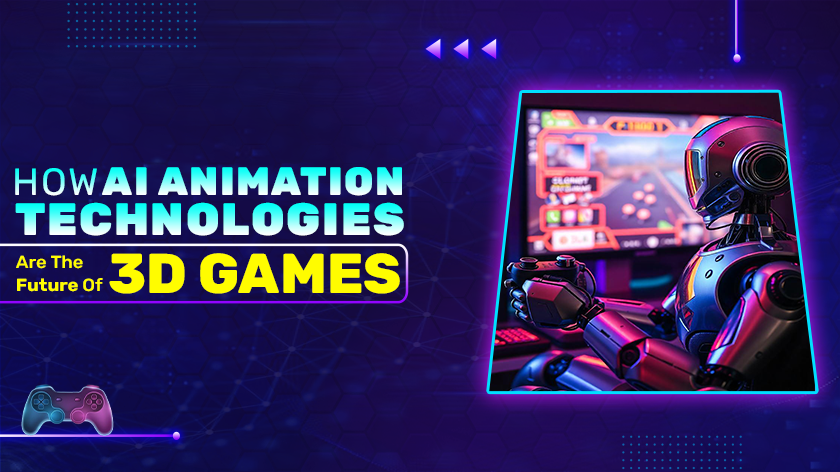AI can determine how a character’s body should move when they jump, for example, based on terrain, wind resistance, and other dynamic factors. In addition to delivering a constant and realistic gameplay experience, this speeds up the development process. Additionally, as deep learning models gain experience from in-game occurrences, they can become even more accurate at simulating physics in games to come.
1. Automating Character Animation: In traditional game development, animating characters is a labor-intensive task that requires countless hours of manual keyframing and motion capture editing. AI is revolutionizing this process through procedural animation. AI algorithms can automatically generate fluid and realistic character movements based on pre-set parameters or learned behaviors.
For example, AI systems can dynamically animate a character’s gait, facial expressions, or combat maneuvers based on real-time gameplay interactions. This technology not only reduces the need for manual animation but also allows characters to react more naturally to in-game events, giving players a more immersive experience.
2. AI-Driven Motion Capture: Motion capture (mocap) has long been used to create realistic character animations by capturing the movements of human actors. However, traditional mocap setups are expensive and require specialized equipment. AI-powered motion capture technology is now democratizing this process by reducing costs and increasing accessibility.
AI tools can analyze and generate animations from simple video recordings, allowing game developers to create realistic character movements without the need for sophisticated hardware. AI-driven mocap systems can even fill in missing data or improve the accuracy of captured movements, resulting in smoother animations and more lifelike characters.
3. AI in Procedural Animation and Physics: Games today require complex physics and animations to create realistic interactions between characters, objects, and environments. AI-powered procedural animation tools allow developers to simulate physics-based interactions without manually coding each event.
4. AI-Assisted Facial Animation: Facial animation is crucial in modern 3D games, particularly in genres that rely on strong character-driven narratives. Historically, animating faces to express emotions like happiness, sadness, or fear required manual keyframing or extensive motion capture. AI is changing this with automated facial animation systems that can generate lifelike expressions from text input or voice data.
AI is capable of, for instance, analyzing a character’s speech and automatically coordinating lip motions and facial expressions with the speech. Character interactions can now be more fluid and realistic-looking, negating the need for laborious manual modifications. We may anticipate ever more complex and emotionally charged facial movements in 3D games as AI models advance.
5. Exploiting Environment and Asset Creation: Beyond characters, AI animation technologies are also revolutionizing the way 3D game environments and assets are designed. AI tools can generate animated objects like trees swaying in the wind or waves crashing against a shoreline, all with minimal human input. This process, known as procedural environment generation, helps developers quickly create rich, dynamic worlds without the need for manual asset animation.
AI can also assist in lighting, shadowing, and texture mapping, ensuring that game environments look visually stunning while remaining consistent. These automated tools free up artists and animators to focus on higher-level creative tasks, accelerating the overall development process.
6. Enhancing NPC Behavior with AI Animation: Non-playable characters (NPCs) are essential to creating engaging 3D games, whether quest-giving allies or adversarial enemies. Traditional methods for animating NPCs often result in repetitive or predictable behavior. AI, however, can enhance NPCs by making their animations adaptive to the player’s actions and the game world.
For example, NPCs in AI-powered games can exhibit more complex behaviors, such as reacting to a player’s movements, adjusting their combat style based on the player’s strategy, or showing emotional responses to in-game events. AI makes it possible to create NPCs that feel more like real characters, contributing to more dynamic and unpredictable gameplay.
7. AI Animation’s Prospects in 3D Game Development: AI and animation technology combined will shape 3D game development in the future. AI will allow creators to push the envelope of creativity even further as it develops. Artificial intelligence (AI)-powered animation tools are already cutting expenses, speeding up development, and improving the creative process. AI frees developers to concentrate more on narrative, gaming dynamics, and innovation by automating monotonous chores.
Moreover, AI’s ability to learn and improve means that future AI animation tools will become even more sophisticated, offering more precise control over character movements, environmental interactions, and player-driven narratives. This opens up new possibilities for game genres, from hyper-realistic simulations to procedurally generated game worlds that offer endless replayability.
Conclusion
AI animation technologies are not just tools of convenience—they are driving a revolution in 3D game design. From automating character movements to enabling adaptive NPC behavior, AI is transforming the way games are developed and experienced. As these technologies advance, we can expect even more immersive, visually stunning, and interactive 3D games in the future, where AI plays an integral role in every facet of creation.
Ready to elevate your game development process? Contact Xceltec to explore cutting-edge AI animation solutions tailored to your needs. Unlock the potential of AI-driven technology and create the next generation of immersive gaming experiences!
For more information: https://www.xceltec.com/
 :
https://in.pinterest.com/xceltec0192/
:
https://in.pinterest.com/xceltec0192/












